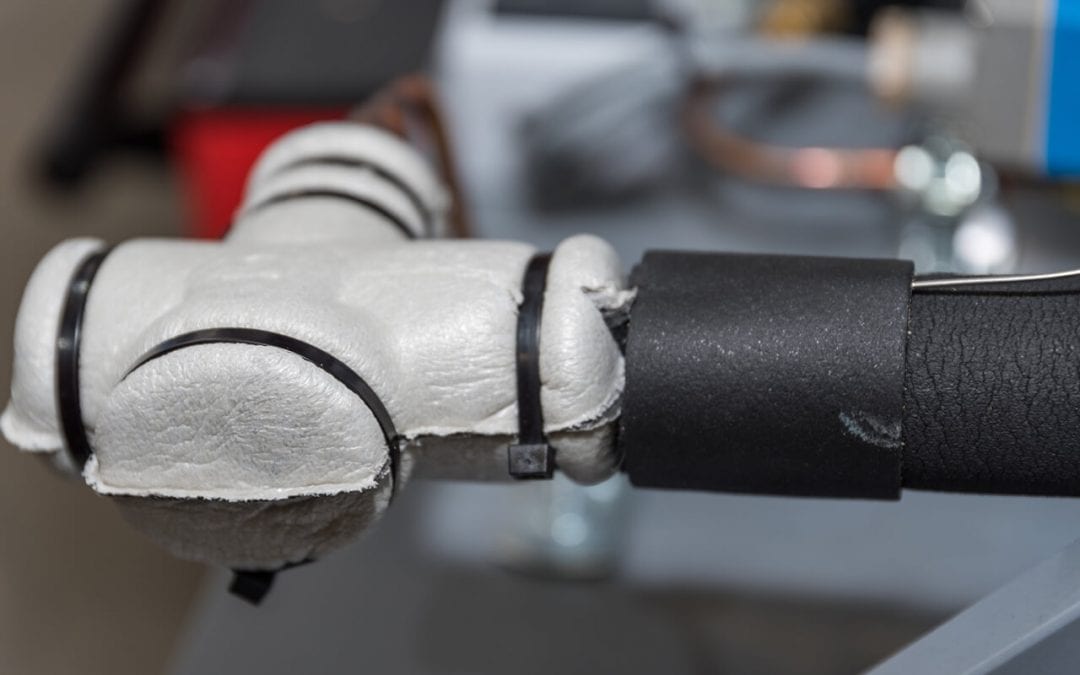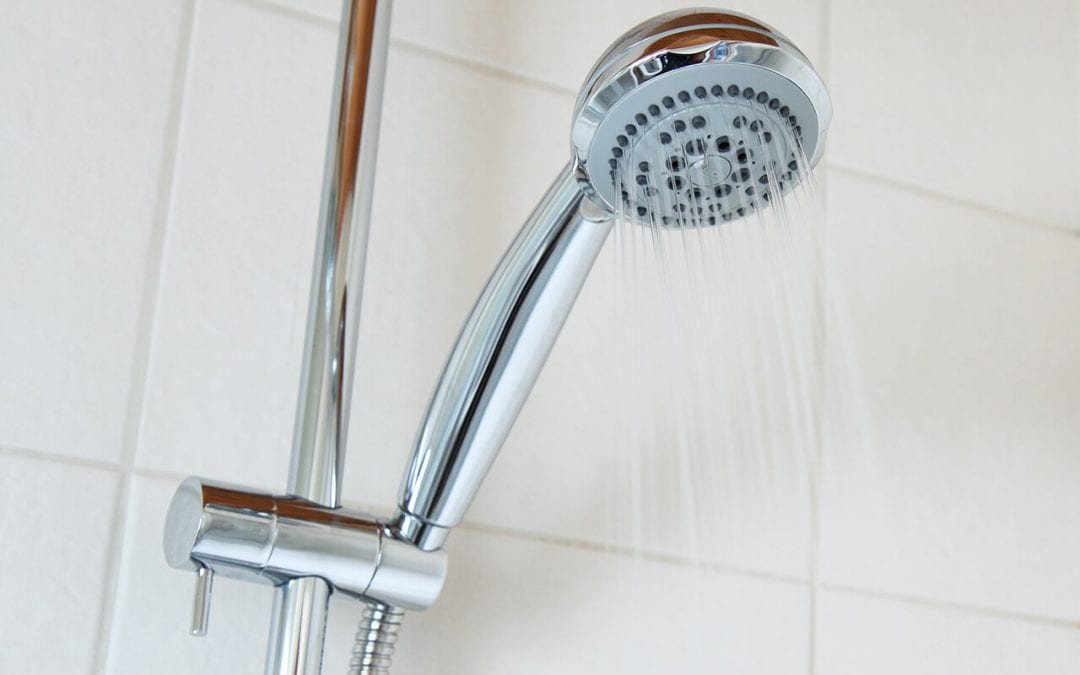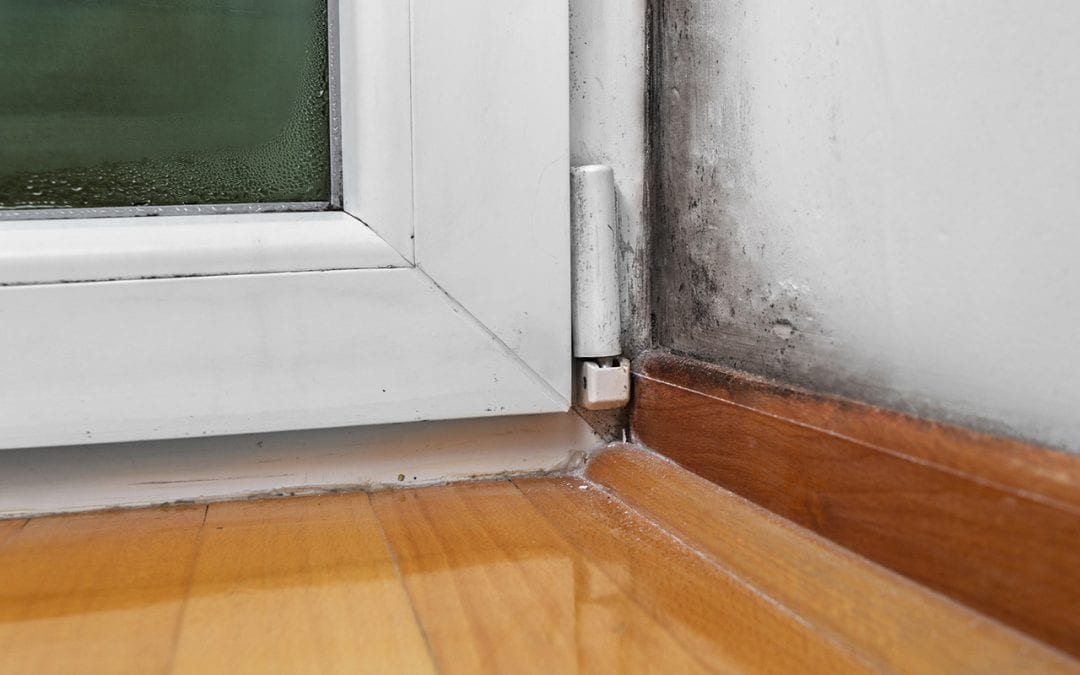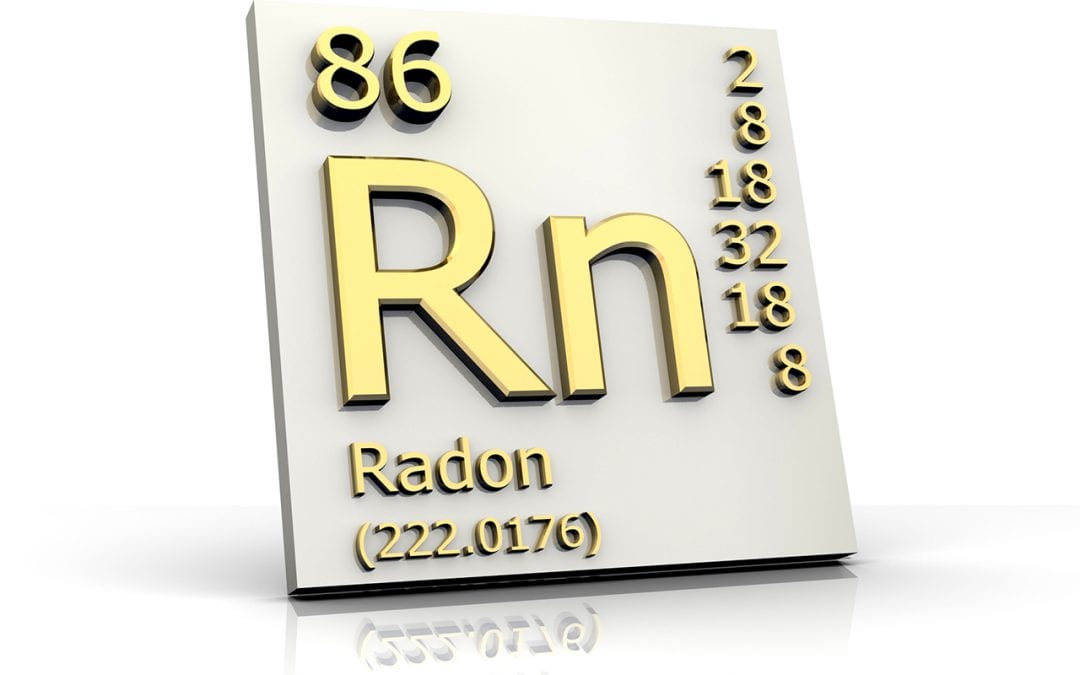
by mwonfor | Nov 19, 2018 | Community, Home Inspection, Home Maintenance, Homeowners
Preventing Plumbing Leaks at Home to Avoid a Hassle
It is in your best interest as a homeowner to keep your plumbing system in good shape. By taking precautions to prevent plumbing leaks, you are more likely to avoid a plumbing emergency. Plumbing leaks tend to happen more in winter because of freezing temperatures. Try these four methods for preventing plumbing leaks at home so you don’t have to deal with a water interruption, damage, and an expensive plumber’s bill.
1. Insulate Exposed Plumbing
When a pipe freezes the frozen water expands and can cause the pipe to burst. To prevent the damage that a burst pipe can cause, use foam pipe insulation on all plumbing that is outdoors, in the crawlspace, or in an unheated basement. Wrapping your exterior faucets and disconnecting garden hoses will also protect your pipes from the cold.
2. Inspect Appliance Hoses
The hoses on appliances like your washing machine, dishwasher, and fridge don’t last forever. It is common to neglect these hoses until they spring a leak. Check these hoses for cracks, moisture, or if they just feel brittle. Installing replacement hoses before they fail is an easy and inexpensive home maintenance task.
3. Check the Water Pressure
Excessive water pressure puts stress on plumbing pipes and can wear on them over time. You can adjust the water pressure in your home yourself. It is recommended to keep your water pressure in the ballpark of 40-45 psi. to improve the life of your plumbing system and prevent plumbing leaks at home. Never let your water pressure go above 60 psi.
4. Install a Water Softener
Some cities’ municipal water supply is rich with minerals, or “hard”. While this may have health benefits, it is not healthy for your pipes. A precaution for preventing plumbing leaks at home is to install a water softening system to remove some of the mineral content. These systems can be purchased at home improvement stores and installed by a handy homeowner.
American Home Inspection Services serves Southeast Michigan with home inspection services. Contact us to schedule an inspection.

by mwonfor | Oct 19, 2018 | Community, Home Inspection, Home Maintenance, Homeowners
Clean water is a limited resource and many are increasingly aware of this due to the water problems Flint has experienced in recent years. While this alone may be enough to encourage you to find ways to save water at home, you may also want to reduce water consumption in an effort to save money on your utility bills. If you are serious about conserving water, consider making a few home improvements to get impressive results.
Find New Ways to Save Water at Home
If you are like many others who have been interested in reducing water consumption, you may have tried to save water at home by adjusting bathroom habits. For example, you may now turn off the water while you brush your teeth and limit your time in the shower each day.
When you and everyone in your home makes these adjustments you can save a substantial amount of water over the course of a year. However, you may now be looking for a new way to save water at home so that you can enjoy even better results. If you are ready to save more water, consider making these home improvements in the near future.
1. Low-Flow Plumbing Fixtures
The amount of water that you use is directly related to the pressure or flow of the water in most cases. Consider that you may turn the water faucet on more forcefully when you need to wash your hands and you may blast the water at full force when you are showering.
Low-flow plumbing features use aeration to deliver a powerful stream of water as desired, but less water is used in the process. Aerated faucets can be installed in all of your sinks and showerheads. A similar design is available for toilets. You can potentially save hundreds of gallons of water each week by upgrading your fixtures to be more efficient.
2. Rainwater Collection and Storage Features
When you are looking for ways to save water at home, it is important to consider how you can maximize rainwater. Without a rainwater collection and storage system, the potential for using rain is lost.
For example, the lawn and vegetation may receive ample rain during a shower, but all of the rain that falls onto your roof and through your gutters runs off into your driveway or landscaping. Try connecting your gutter system to a rainwater storage tank so you can collect this runoff to use around your lawn and gardens. By taking this step, you can eliminate the need to draw water from the public water supply to keep your lawn or garden hydrated.
3. Upgrade Your Appliances
Your dishwasher, washing machine, toilet, and hot water heater make up a lot of your water consumption. You can upgrade your dishwasher and washing machine to WaterSense and ENERGY STAR® certified models that use less water to do the same job. A tankless hot water heater is another upgrade to consider. Because a tankless hot water heater heats water on-demand, you can draw hot water when needed.
You can see that there are numerous improvements that you can make to save water at home on a regular basis. Consider starting with one improvement to begin conserving water, and you can gradually make additional improvements for further conservation.
American Home Inspection Services provides home inspection services for Southeast Michigan, including water testing and well inspections. Contact us to schedule an appointment.

by mwonfor | Sep 20, 2018 | Community, Home Inspection, Home Maintenance, Homeowners, Seasonal
Summer has come and gone and fall is nearly upon us. The kids are back in school, so pack away all the camping, swimming, and other fun summer gear and make sure your home is ready for the first of many cooler days. Use the following 8 tips to help you prepare your home for fall and the coming winter. Doing so will protect you and your home, save you money, and help your home look better next spring.
1. Fertilize the Lawn to Prepare Your Home For Fall
Protecting your lawn over the winter will help it grow more lush and green the following spring. The hot summer stresses grass. Help refortify your lawn with a good dose of fertilizer now. Not only will you enjoy an attractive lawn next year, but your neighbors will also appreciate your efforts.
2. Drain Outdoor Faucets and Sprinklers
Don’t turn your patio, walkway, or driveway into a skating rink overnight. Before that first freeze comes unexpectedly, turn off and drain outdoor water faucets, hoses, and sprinklers. Then you can take steps to prevent pipes from freezing and bursting when the temperatures drop to very cold for long periods.
3. Drain and Store Gardening Equipment
Around mid-October, or earlier if you live far north, mow your lawn for the last time of the year. After that, drain the tanks of your lawn mower, weed eater, and other lawn equipment. If you don’t, unused gas will lead to gunk and other harmful buildups that may ruin your equipment, leaving you to replace it in the spring. Now is a good time to sharpen mower blades.
4. Clean the Gutters
Cleaning the gutters is an important task to prepare your home for fall. Clogged gutters can eventually lead to a damaged foundation and a host of other problems. Grab a ladder and someone to help you to make this task easier. If your house is one story, there are leaf blower attachments available that will help get the job done. If needed, hire professionals to clean the gutters.
5. Get Your HVAC Serviced
Your AC has worked hard all summer and now’s a good time to prepare it for a long winter’s rest. Clean the coils, filters, and air ducts, or you can hire someone to do it for you. Once clean and dry, cover the unit to protect it from debris and ice. Switch thermostats from cooling to heating. Prepare your furnace for its first use this season by cleaning the combustion chamber, inspecting the flue pipe, and changing the filters. Help your heating system function more efficiently by checking for leaks around windows and doors. Use weather stripping and caulking to seal any areas that aren’t airtight.
6. Check and Clean the Chimney
Checking your chimney is an important safety tip to prepare your home for fall. The last thing you want is for smoke, soot, or carbon monoxide to fill the room. Even gas fireplaces need chimneys inspected for bird or squirrel nests blocking the flue. Chimney pipes need to be free of cracks so smoke won’t enter the room. Inspecting and cleaning chimneys is best left to the professionals.
7. Inspect the Roof
Conduct a complete inspection of your roof, or hire a professional home inspector if you are not comfortable. Look for loose, missing, or curled shingles, and wind damage. Stop problems that may turn into leaks through the wind, rain, and snow of winter. Check gutters for loose shingle granules, which may be a sign you need a new roof.
8. Get Ice Melter and Snow Shovels Ready
The first cold, snowy spell can be a surprise, leaving customers scrambling for supplies at the last minute. Beat the crowds and get ice and snow-clearing supplies and equipment ready now to prepare your home for fall. You may even consider investing in a snow blower so that you can avoid strenuous snow shoveling. You will likely save money by buying them when they are not in such high demand.
In Michigan, it can turn from fall to winter very quickly. Be sure to check out our post about preparing your home for winter.
American Home Inspection Services serves Southeast Michigan with home inspection services. Contact us to schedule an appointment.

by mwonfor | Aug 20, 2018 | Community, Home Inspection, Home Maintenance, Homeowners, Mold Inspection
Look Out For These Signs of Mold
People do many things to make sure their homes are clean, safe, and healthy for their families. A big threat to a healthy home is mold growth. To know for certain whether there is mold in your home, you need to hire a professional to conduct a mold inspection. The home inspector will often perform air, surface, and bulk mold tests to compile conclusive results. It is important, however, for homeowners to know the signs of mold in their home. To identify the signs of mold, here are some of the things to check out.
1. Mold Smell
One of the major signs of mold in your home is its smell. If mold is in the house, the smell will be a bit damp and sometimes musty. If you smell anything that indicates the presence of mold in your home, call a professional home inspector who specializes in mold. Ignoring this sign could cause more damages to your home.
2. Presence of Water In Your Home
When you have broken pipes, leaks, or your sewer line bursts, your home is likely to experience water damage. This is a major problem in flood-prone areas. Water damage is often followed by the growth of mold in your home because of the damp conditions. As a result, you should always act fast when you notice water intrusion in your home. If you can’t clean the water out by yourself, you should consult home restoration professionals in your area.
3. Health Problems
When you experience health problems like allergies in your home, this could be a sign of mold. When hypersensitive individuals inhale mold spores, they may experience breathing problems due to the blockage of the airways. Some of the symptoms may be sneezing, a running nose, coughing, watery eyes, and dry, itchy skin.
Mold as an allergen has also been associated with asthma since it causes the above symptoms in addition to wheezing, shortness of breath, and a tight chest. If you do not clean out the mold in your home and seek immediate medical attention, these health problems may worsen.
4. Water Leaks
Water leaks may come from the roof, cracks in the wall, windows, doors, and other openings throughout your home. When water leaks within your home, you may notice mold growth or it may be hidden behind walls and not visible. This is where the services of a home inspector come in handy.
5. Previous Flooding
For people who reside in flood-prone areas, the probability of mold growing in your home after it has flooded is high. The problem will be worse when you stay for long without cleaning your home. This is because water damage is always accompanied by mold damage. After flooding in your home, you should take time to seek professional services from mold remediation specialists. The specialists will inspect all the visible and hidden parts of your home to assess the damage.
6. Visible Mold Growth
When you begin to smell mold, you’ll likely also see mold growth in your home. Note that even the smallest spot of mold could grow and cause damage to your home and negatively impact your health. This means that you need to contact a professional mold cleaning agent to restore your home.
American Home Inspection Services serves Southeastern Michigan with home inspection services, including mold inspections. Contact us if you have concerns about the signs of mold in your home.

by mwonfor | Jul 19, 2018 | Community, Home Maintenance, Seasonal
Spring seems to be the time when the lawn takes care of itself. A lawn that was dormant all during the winter suddenly comes back lush and green. It does not seem to need mowing very often, and if rain is abundant, it may not even need to be watered. However, the heat of summer can make lawn maintenance more difficult. Here are tips to help maintain a healthy summer lawn:
For a Healthy Summer Lawn, Fertilize Every 6-8 Weeks
Fertilizing strengthens the grass and helps it endure summer’s heat and drought. A slow release fertilizer is best when applied in early Spring, and there are different fertilizers depending on whether the lawn is in the north or in the south. Keep feeding the lawn every 6-8 weeks until the fall. Some fertilizers come with additives to control pests and help the lawn retain water.
Don’t Cut It Too Short
Though the grass may be growing quickly by summer, it still should not be mowed more than a third of the height of the grass blade for a healthy summer lawn. Tall blades are better able to send their roots deep into the soil to find water, and they also shade the soil beneath which keeps the ground cool and discourages weeds. Though some homeowners think it’s a little unsightly, it’s best to leave the grass clippings on your lawn after mowing. They provide valuable nutrients that contribute to a healthy summer lawn.
Treat for Grubs
If grubs are a problem when it comes to the lawn, the earlier they are dealt with the better. One natural way is to add beneficial nematodes at about 50,000 per square foot of lawn. Milky spore powder also takes care of grubs, as does 5 percent rotenone solution, pyrethrin, and neem oil.
Eradicate Weeds While They’re Seedlings
As for weeds, it’s best to eradicate them while they’re still young. Some weeds can be treated with an herbicide that doesn’t hurt the grass, while others are so invasive that they need to be pulled up from the roots.
Water Deeply and Early for a Healthy Summer Lawn
During the midsummer, it’s a good idea to check how deeply the water penetrates the lawn after it’s watered. The best time to water the lawn is early in the morning so the soil is able to absorb the water before it evaporates in the hot sun.
American Home Inspection Services is Southeastern Michigan’s premier service provider for home inspections, commercial inspections, radon testing, mold inspections, mobile home inspections, and home watch services. Contact us to schedule your appointment.

by mwonfor | Jun 20, 2018 | Community, Home Inspection, Home Maintenance
Before purchasing a home, it is important to first have a home inspection and a radon test. If there are high levels of radon present in the house, there are a few ways to reduce radon levels and minimize the risk to your family’s health.
As a colorless, odorless gas, radon cannot be seen or smelled, but it still may be present in your home. The EPA reports that radon is the second-leading cause of lung cancer in the United States. Found in soil, radon seeps into the home through cracks, doors, windows, and other openings. When it becomes trapped in the house, people in the home unknowingly breathe in the substance and cause damage to the cells of the lungs.
How to Reduce Radon Levels in the Home
Radon is found everywhere. As many as one-third of all homes have a higher amount of radon in the air than the EPA’s recommended maximum safety level. Since you cannot see or smell this gas, testing is the only way to learn if radon mitigation should begin. The EPA recommends annual professional radon testing to reduce risks. There are many ways to reduce the radon levels in the home now and after testing. You should:
- Seal all entry points into the home, since this is where gas leaks into the home. It is also a source of energy loss. Check areas around the foundation, the plumbing system, the basement, and sump pumps. Always seal cracks.
- Ensure there is proper ventilation in your home. Without proper ventilation, there is more pollution in the home and it also draws in radon and other harmful gases.
- Install ventilation in crawl spaces and around the foundation to reduce radon levels.
- Use the ceiling fan to help circulate air around the house and to remove toxins from the air. The ceiling fan reduces the plate-out or the energy charge released from radon that damages the tissues of the lungs.
The Radon Inspection
Professional home inspectors use a variety of techniques to measure radon levels in a house. Passive devices do not require power to test for radon while the active devices do require power. The inspector will determine which inspection technique is best for your home. Both short-term and long-term inspections are available. If you’re buying a home, the short-term inspection, including two to three-days of tests, is likely to be the technique used. It is a good idea to use a long-term inspection later down the road and to have your home tested regularly for radon.
What is a Radon Mitigation System?
Professional radon mitigators can help homeowners develop a plan of action to minimize the radon levels in their home. The EPA recommends that homes have radon levels no greater than 4 pCi/L. If an inspection shows that levels are higher than this number, it is important to develop a mitigation plan at once. Although radon is not visible and has no smell, it can be deadly. Put a plan in place if high radon levels threaten your home and health.
American Home Inspection Services provides radon inspections to Southeast Michigan, along with other home inspection services. Contact us if you need your home tested for radon.






